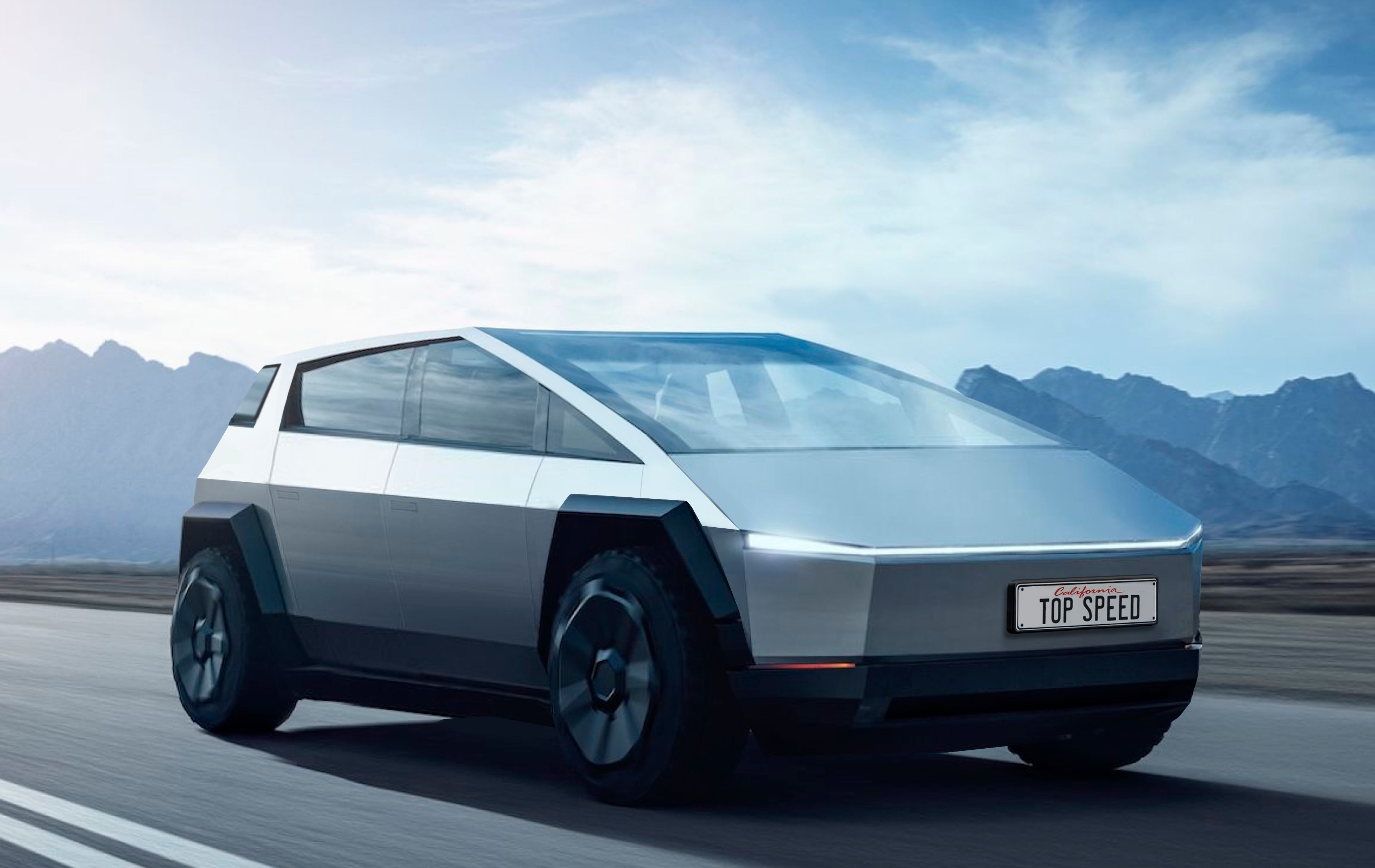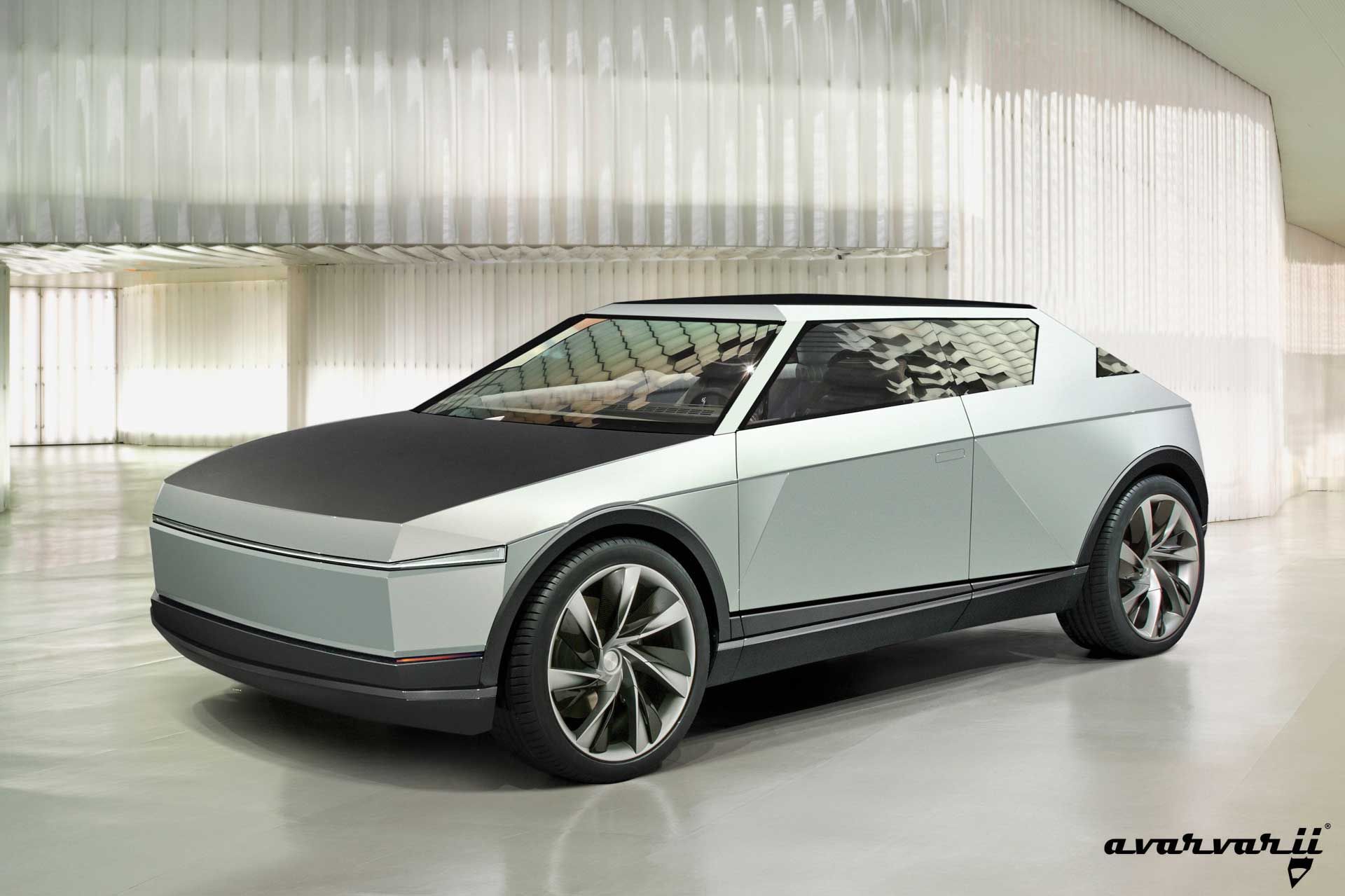The Tesla Cybertruck put the car industry in shock with its outlandish design,incredible performance, and the best range ever announced by the American automaker. All this at an incredible starting price of $39,000! The Cybertruck quickly prompted rumors that Tesla could also create its cheapest model yet, thanks to its revolutionary exoskeleton: enter the Cybercar. That new vehicle would be perfect to serve as the Robotaxi fleet Elon Musk talked about in recent years, but what would a Cybercar look like and what will it bring to the market?
What the Tesla CyberCar Will Look Like
The Cybertruck’s design is incredibly controversial and, while some love it for its unique and daring look, others would kill it with fire in a second. But the Cybertruck’s design has a lot to do with practicality. It’s incredibly aerodynamic and shaped like that due to the fact that it’s built from cold-rolled stainless-steel panels. This material is tougher than anything else used in the auto industry. As such, it makes a lot of sense to picture upcoming vehicles featuring the same construction technique and materials. We went ahead and rendered two versions.
Our first rendering is a four-door wagon-style vehicle that looks a lot like the Cybertruck. It features a similar front end and a similar polygonal cabin, but with some changes to the rear. Instead of a tonneau cover, this car features a tailgate and some storage room behind the second-row seats. It’s not as practical as the Cybertruck, but it would be a perfect candidate for the Robotaxi project. It has room for five people, decent trunk space, and it’s compact enough for busy city streets.
Granted, Tesla built two-door cars before and will do so again with the Roadster 2.0, but it has yet to deliver a full-fledged hatchback before. This doesn’t mean that it can’t happen.
And beyond the hatchback body style, this rendering is also heavily based on the Cybertruck. While the four-door above is suitable as a Robotaxi, this two-door hatchback would work better as a more traditional passenger car.
How Can Tesla Make a Cheaper Car?
There's no doubt about it, the Cybercar has to be cheap. The Model 3, currently Tesla's most affordable model, comes in at $39,490 before potential incentives or gas savings. Tesla says incentives can reach up to $1,875, so this means that the cheapest Model 3 would cost $37,615.
Part of this is due to the fact that it's smaller than the Model 3, but also because Tesla needs to get to the point it promised years ago. Also, a sub-$25,000 electric car would be a breakthrough for the market. So how can Tesla do that?
What is the Exoskeleton and how will it save Tesla tons of money?
First, we need to understand what Exoskeleton means.
This is a design that goes against current trends for large trucks, which still feature the traditional body-on-frame construction because of the strength provided by a ladder frame. The unibody layout is usually found in cars and smaller crossovers, in which the body actually serves as part of the structure, but it's nowhere near as strong as body-on-frame construction. So why is the Cybertruck a unibody instead of a body-on-frame design?
Getting back to the exoskeleton, the Cybertruck's outer shell, or what we perceive as the exterior, is, in fact, folded to create the shape of the truck. That’s why there are very few seams between body panels and why the gaps between the doors are so thin.
How is The Exoskeleton Stronger Than Normal Unibody Designs?
The one used by Tesla in the Cybertruck is most likely the 301, a stainless steel with excellent corrosion resistance and a high strength-to-density ratio.
This material is directly responsible for the Cybertruck's outlandish design.
In an automotive plant, the stamping press is arguably the most expensive equipment. That’s because this machine is very complex and uses massive amounts of force to turn a flat piece of metal into a body panel like a hood, door, or fender. Tooling for the stamping press is also expensive, as an automaker must create several shapes for each part made in a multi-stage process. Because the stainless steel used in the Cybertruck isn't heated in the traditional way and is so tough, a stamping press can't be used.
The Tesla Cybercar Will be Cheap Before Pretty
Fact: Stainless steel isn't the cheapest metal to manufacture, but it's significantly cheaper than aluminum.
While cold-rolled stainless steel panels will help Tesla reduce costs by not using a stamping press, the Cybercar won't be as pretty as the Model 3 or Model S. That's because it will look a lot like the Cybertruck, as seen in our renderings above. Given that many enthusiasts consider the Cybertruck ugly, it's safe to say that the Cybercar will be just as controversial design-wise.
But the cold-rolled stainless steel construction and the almost flat body panels aren't the only features that save costs.
The Cybercar will also make heavy use of plastic. The wheel arches, the bumper, and pretty much every other surface that's not flat, hence it can't be made from cold-rolled stainless steel, will be made from this cheap material. And that's a really good idea, because not only it will keep price down, but it will also help keep weight down, which is essential for an electric car.
Tesla will probably apply the same principle inside the cabin, as it already did with the Cybertruck. The hauler features a rather simple interior. Take the dashboard for instance, which looks like a marble table. The dash is made of paper composite that has been baked at extremely high temperatures until a dense and durable material was created. It's also water-resistant, environmentally friendly and, more importantly, cheap to produce.
A simple Cybertruck-like design is what will help keep the Cybercar well below the $30,000 mark
All told, don't expect the Cybercar to feature a fancy interior. But before you get all fussy about it, remember that a simple Cybertruck-like design is what will help keep the price well below the $30,000 mark.
No Paint Saves Money
Fact: The paint on an average sedan can weigh up to 11 pounds !
This is a simple fact that we tend to ignore. Painting cars is expensive. Not because the paint itself is expensive, but because painting a car requires a paint shop and a lot of time. It also requires development of various paints, including custom finishes with three layers, metallic flakes, and all that jazz. Setting up a production paint shop costs hundreds of thousands of dollars, and all of it will go into the final price of the car.
But won't the Cybercar rust to pieces without paint? Well, no. That's exactly why Tesla adopted cold-rolled stainless steel.
Not having paint on a car's body also contributes to a lower curb weight. This is a strategy some have been using since the early 20th century. By 1930, aircraft manufacturers were already using polished and unpainted aluminum body panels for streamlining purposes and to save weight. Mercedes-Benz was among the first carmakers to apply a similar strategy. The story is still somewhat controversial, but word has it that Mercedes stripped the white paint off its Grand Prix racing cars to meet a maximum weight limit introduced in 1934. Back then, GP cars were required to tip the scales at 750 kg and the then-new W25 race car weighed in at 751 kg. So Mercedes reportedly got rid of the extra weight by scraping the paint and leaving the W25's sheet metal exposed. And this is how the iconic Silver Arrows were born.
But the Silver Arrows were rather small, didn't have actual fenders and bumpers, so there wasn't much bodywork to be covered with paint. This means that modern road cars, which are larger and have more elements to be painted, can become notably heavier due to the colored coating. The question is, how much weight will paint add to a car?
To find out, I checked out an interesting experiment by Velocity Labs. To keep things simple, he painted a one-square-foot panel, weighed it before and after the paint job, and then estimated how many square feet of painted surface a car has. He went with a Mitsubishi Eclipse, a rather small vehicle compared to your run-of-the-mill sedan. He added three layers of primer, three layers of paint, and three layers of clear coat to the one-foot-square panel, which gained 26 grams. With the Eclipse estimated to have around 150 square-feet of bodywork, it resulted that paint would add around 8.6 pounds (or 3.9 kg) to the car. And that's a significant amount.
But things become much more interesting with larger vehicles. According to Velocity Labs, a compact sedan has an even larger body surface of around 200 square feet, which means that the paint may add at least 11 pounds (about five kg). All told, Tesla will shed significant weight if it keeps the stainless steel Cybercar unpainted.
And this will make quite the difference for an electric car, which depends on weight for efficiency.
The Tesla Cybercar Doesn't Need to be Fast
Mostly a compact car for crowded city streets, the Cybercar doesn't need to be as wild as all the other models in the Tesla lineup. This means that Tesla can reduce costs by fitting a smaller battery and a one-motor drivetrain. When it comes to the powertrain, arguably the most expensive component is the battery stack. Batteries are expensive to produce and force automakers to spend even more on finding solutions to fit them in the car without completely ruining weight balance and passenger space. The same applies for the Robotaxi, which will actually need to run at low speeds in order to transport passengers in safety. So what kind battery will we find in the Cybercar and Robotaxi?
While Tesla now only offers 100-kWh batteries in the Model S, it used to feature smaller stacks as well. At various points, the Model S featured 90, 85, 75, 70, and 60-kWh batteries. Heck, Tesla even offered a 40-kWh battery in the early days.
But range increases 249 miles with the 75-kWh battery and a single motor, and that's not bad for the Cybercar and Robotaxi.
However, we want more range in a city car, so maybe Tesla will develop an even better yet still compact battery. Assuming it won't become very expensive, that is. Another solution is to fit the Cybercar and Robotaxi with the drivetrain in the base Model 3. This single-motor, RWD, Standard Range Plus model returns 250 miles per charge and hits 60 mph in 5.3 seconds. Its top speed isn't bad either at 140 mph, but we already agreed that performance isn't very important here.
This drivetrain keeps pricing of the Model 3 at $39,490 before incentives and less than $38,000 if we take government rebates into account. With the lower costs associated to the stainless steel construction and the cheaper materials inside the cabin, a smaller-battery Cybercar should cost significantly less than $30,000.
The Cybercar Could have a Retractable Steering Wheel or None at All
When Elon Musk first announced the Robotaxi, he said that the first vehicles would be ready for 2020.
In Musk's own words, a fully autonomous Robotaxi will automatically become more affordable as features such as the steering wheel and the pedals will no longer be necessary. So this is a win-win situation in which the Robotaxi is cheaper, while front-row seat comfort increases for the passenger sitting on the left side. The extra space could also allow sufficient room for three passengers on a front-row bench, expanding the Robotaxi's capacity to six people, more than the usual sedan.
The same will apply for the Cybercar. A level-five autonomous car would no longer need to be operated by a driver, so the price will drop dramatically without a steering wheel and a set of pedals included in the building process.
Tesla Cybercar Range
Range is an extremely important aspect for both the Cybercar and the Robotaxi. Beyond cost and beyond the ability to take you from A to B in complete safety, the Cybercar needs to be able to travel without charging too often. Tesla already offers production cars with up to 373 miles of range per charge and the Cybertruck promises to deliver more than 500 miles, but will the Cybercar and Robotaxi provide something similar?
The main issue here is the size of the battery. The Model S and Model X are large enough for batteries that provide almost 400 miles of range, while the Cybertruck is big enough for a battery good for 500 miles. The Cybercar and the Robotaxi, on the other hand, will be much smaller vehicles and they must be cheap to make. And, as we already discussed, a smaller battery means a cheaper car.
The dual-motor layout is good for 322 miles, but this drivetrain may add too much to the Cybercar's sticker.
But there are plenty of variables we don't know yet. The Cybercar could have a more advanced regenerative system that could extra more juice for the battery when braking.
Once a system like this is in place, range won't be much of an issue. Sure, the Robotaxi will still travel a lot and would needs at least 250 miles of range per charge, but a scenario in which taxis need to takes breaks to recharge is completely manageable in a fleet.
Why Tesla Needs a Cheaper Car
The obvious one here is that electric cars need to become more affordable for the average Joe. At almost $40,000 including government rebates, the Tesla Model 3 is as affordable as Elon Musk promised a couple of years ago. A Cybercar that will cost less than $25,000 before incentives would be a massive breakthrough for both Tesla and the electric car market. It would be affordable to more people and it would obviously increase Tesla's sales worldwide. But that's just one good reason out of many others.
Smaller Cars Are Becoming More Common in Crowded Cities
It's common knowledge that while gas and diesel cars sip more fuel in the city and heavy traffic conditions, electric cars reach their efficiency peak in the exact same conditions.
So how can we (and Tesla) have more electric cars on the streets? By making them more affordable.
Robotaxis Everywhere
Elon Musk doesn't want to launch a few Robotaxis to test a concept for the future.
“From our standpoint, if you fast forward a year, maybe a year and three months, but next year for sure, we’ll have over a million Robotaxis on the road,” Musk said during the event. "The fleet wakes up with an over the air update; that’s all it takes.”
He even went as far as to say that the company's attention will shift on the Robotaxi project. The main consequence of this will be that regular Tesla models will become significantly more expensive in order for supply to meet demand.
"To be clear, consumers will still be able to buy a Tesla, but the clearing price will rise significantly, as a fully autonomous car that can function as a Robotaxi is several times more valuable than a non-autonomous car," Musk said on Twitter back in July 2019.
On the flip side, the Robotaxi won't be deployed everywhere in the U.S. at first. Musk noted that the company might not get regulatory approval everywhere, so the Robotaxi may arrive in certain states later than in others. But when this happens and the Robotaxi takes the market by storm, they need to be cheap and simple to produce, even if the end consumer has to pay a small fortune for one. If major fleet owners join in, demand will quickly exceed supply, so Tesla needs a steady production flow.
Robotaxi Will Use Approved Routes Only
Speaking of regulatory approval, this shouldn't be very difficult for Tesla to obtain.
To be more specific, the Robotaxi could avoid complex intersection and routes, as well as zones that are known for frequent accidents. The Robotaxi could also avoid school zones or areas with poor road conditions and traffic jams. This would actually be easy to program, as the car's "brain" will be linked to the navigation system, which is aware of difficult-to-drive zones and traffic jams - in a dynamic and on-demand basis as well. The Robotaxi will be the smartest car ever designed.




